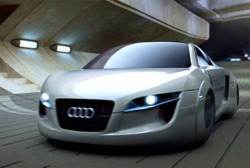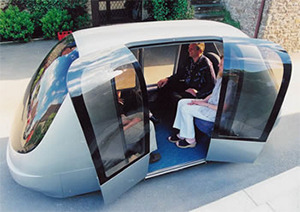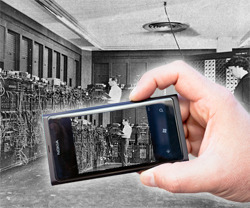Steven Lyle Jordan's Blog, page 61
January 23, 2013
New section: Press Releases
For those who like traditional press releases (for posting and reporting elsewhere… hint, hint), the new Press Releases section is your stop for official news on Steven Lyle Jordan books. You’re welcome!


January 20, 2013
Reviewers wanted.
Seeking SF readers or authors interested in reviewing an advance copy of Sarcology (to be returned by March). Email rbea@rightbrane.com if interested.


Sex and the robotics trade

You know you would.
Robotics has always had a very real dichotomy, a chasm separating the vision and the reality. Where imagination has given us human-like robots like Parody, the Terminator, Data and Gigolo Joe… reality has given us auto factory welding machines.
Yet, as technology surges inexorably forward, and companies have taken to animatronicizing mannequins for tech and auto shows, the supposed likelihood of achieving robots that can substitute for humans remains just around that imaginary corner.
If we do turn that corner… will we find a red light district there?
My upcoming novel Sarcology features a robot that is capable of having sex with humans. Sex with robots is not common in the book’s setting of 2040, due to the relatively early state of the robotics industry, but it isn’t unheard of, and it’s not as unacceptable as it would be considered today. It represents a social meme that bears close study.
Let’s face it: It’s so much fun to consider a world where humans can have sex with robots. After all, we can imagine a world where the availability of robots completely removes the human trafficking problem, saving hundreds of thousands of people (including a frighteningly large proportion of minors) from bondage and sex servitude. Who could argue with that?
And giving robots sex duty would cut down on unwanted pregnancies, and hopefully, finally begin the much-needed process of bringing the human population count down to more manageable levels (without applying bombs and plagues, that is). That prospect alone might be a good enough reason for some countries to pass mandatory laws requiring citizens to get their rocks off with robots and take the pressure off their families and the state.
Robots for sex also seems to solve one of the great problems of modern American society (so they tell me, anyway): The objectification of the opposite sex. U.S. law maintains a moronic series of “I know it when I see it” sex harassment standards that will never go away as long as Americans refuse to be ADULTS about sex. And since they won’t, we’re probably better off transferring all that sexual tension and angst to robots, and wearing shapeless baggy grey unitards to protect ourselves from our own worse thoughts…
But anyway. Robots.
Futurists have theorized a world where sex robots will be available by appointment. These sex robots would have genitalia specially designed to be quickly cleaned and sterilized after each use (detachable for cleaning? Could be fun to watch, anyway), allowing them to service multiple clients without the risk of transferring STDs from user to user. And these robots would be sufficiently lifelike to satisfy users as much as a human partner, if not more.
So how likely is this? Well, given that we haven’t managed yet to create a mechanical (or computer-generated) creature that could fool a human for long, chances are there’s something about the living mechanism that may never be perfectly mimicked by a machine. Chances are, no matter how good it is, there will always be some tell that will reveal it to be mechanical.
Knowing this, we should also acknowledge that the best of the best robots… the ones more human than the rest, and can fool us for the longest… will likely be so sophisticated as to be too expensive for the average person to gain access to (and you thought $5000 Vegas hookers were crazy). If anyone makes sex robots that are that real, the only place you’ll find them will be in Trump’s bed. (And that’s probably the only thing you’ll find there… HAHAHAHA! uh… ahem.)
For the rest of us, I’d bet a sex robot will look like… a plastic mannequin, or maybe a character straight from a Disney theme park ride, dumb, jerky, clumsy and cheap. Velcro holding the wig on. Doll eyes that close when you lay them down. Tape-recorded responses playing on a loop as you work out. Slightly more realistic than a blow-up doll.
But… does that matter? Not really: Humans have an amazing capacity for transference… assigning human (or at least living) qualities to non-humans and inanimate objects. They can lust after complete strangers in 2-D photos and movies; they can get off with sex toys that only vaguely approximate actual human bodies or body parts; they can do phone sex. Given that reality, it probably doesn’t matter how realistic a sex robot would be… for the right price, people would use ‘em, then sit ‘em in the closet when they were done. And hopefully take ‘em out and clean ‘em every so often.
Sex robots could become common sources of entertainment; and may by virtue of their inhuman nature spur new ways of having and enjoying sex, in singles, couples or groups, employing new and different fantasies, or maybe recording and playing back sessions to share with others (or re-enjoy yourself). Users can enjoy exactly the type of sex they like, as straight or kinky, fast or slow, without having to worry about upsetting, disappointing or going to jail over their partner.
Presently, The U.S. has an under-the-cover (so to speak) love affair with sex toys. All you have to do is check the sales figures to confirm that we’re buying and using them. A lot. But we generally don’t discuss them, except with our closest friends… people don’t recommend their favorite dildo on Facebook.
But sex robots are much larger (so to speak) than the average plain-brown-wrapper-delivered toy… they’d be pretty damned hard to hide. If we did start using sex robots, chances are, it would be almost impossible to conceal them from others. So, either we wouldn’t use them at all… or we’d use them, flaunt them, put them in plain site, and compare our models to the ones the Joneses just bought. No household would be complete without its sex robot… unless you had a membership at the local sex robot spa, which you’d probably transfer to other spas as you got tired of the same old Francis models that they never upgrade, and don’t they have the new Gladys bots at the Rodeo Spa? My friend has a Gladys, he let me try it once, and man, you should see how that thing jumps…
uh… ahem. (Told you this is fun!)
So: Are we likely to someday see a sex robot trade? Probably. Will the sex bots we use seem like real people? Well, for most of us, probably closer to one of the wenches from the Pirates of the Caribbean Ride.
Will we care?
Hey, we’re talking about sex, aren’t we? Pass the lube.
Sarcology will be released in Spring 2013.


January 14, 2013
You want a self-driving car. Think about it.

Self-driving car from I, Robot, courtesy 20th Century Fox
I know. It almost sounds blasphemous. Imagine, a car that drives itself, as do the cars in my new novel Sarcology. No input from a driver, other than telling the car your destination. Then turning your back on the car until it tells you you’ve arrived. It’s crazy. No car could drive as well as you can. No car could get you where you’re going faster or easier than you can. And no robot could be a safer driver than you.
Yet, robotics technology is improving by leaps and bounds every day. Google, using the latest in computers, GPS and sensory technology, has created a car that has run so safely over the past year (one accident, caused by the other car) that two states have decided to make self-driving cars legal on their streets. Other states are already looking them over, as other car makers and experimenters are working on their own self-driving car technology. And in every state, many drivers now gladly watch in hands-off mode as cars park themselves. The writing is on the traffic sign.
And you still don’t want cars to drive you around? Well, maybe you just haven’t thought it through.
First of all, today’s drivers are having enough trouble driving themselves… what with wanting to carry on conversations, talk on cellphones, eat snacks, put on makeup, check Facebook pages, text buddies, watch YouTube videos… and dodge all of the other drivers doing these things so much that they’re paying as little attention to the road as you. Drivers have achieved sensory overload, to the extent that they are paying too little attention to the most statistically hazardous activity in their lives… driving.
And what about those of us who enjoy driving… exactly where can you do that? Between traffic, speed limits, torn-up roads and obstacles, etc, there are precious few places where a driver can “open ‘er up” and really enjoy the driving experience. Might as well let a robot do it, for all the fun it is in reality.
And as robotics tech improves, we are seeing self-drive cars are safer than human drivers, causing and getting caught in fewer accidents. Robotic vehicles can check their surroundings against GPS data and their own internal maps, finding ways around traffic tie-ups, accidents and blocked routes more efficiently than human drivers. They do the thinking, the car gets where it’s going.
And all you have to do is ride with it.
Imagine your own car being essentially like a cab that you own, equipped much like a tiny family room with all of your favorite stuff. As the car does the hard and dangerous work of driving, you can sit back, play video games, browse the web, read, have a beer, take a nap, engage in a conversation, even make out. Or you can carry on business, make conference calls, study the report you’re delivering, google your client info, have a cocktail, polish your presentation, or make out with your business partner. (Wanna get busy? Hope you have tinted windows.) And you can do all of this, knowing that you are in safer hands than your own. The car can even search and find the most convenient parking spot and do a better parking job than you can. Heck, it could drop you off at the door, and then park itself and wait for you to summon it back… door-to-door service, at your command.
 In Sarcology, people are essentially chauffeured, either in their own self-driving cars, or in self-driving cabs, which are also ubiquitous in 2040s Atlanta. Human-driven cars are not allowed anywhere near a city, because of the hazardous realities of human drivers, and about the only thing affected by this development is the inability to break traffic laws to get to your destination. In exchange, passengers can rotate the seats to face each other or sit alongside, and engage in whatever activity they desire along the way, whether it’s talking, eating, drinking, sleeping, working, or even sex. (Yes, it happens in the book. Now stop asking!)
In Sarcology, people are essentially chauffeured, either in their own self-driving cars, or in self-driving cabs, which are also ubiquitous in 2040s Atlanta. Human-driven cars are not allowed anywhere near a city, because of the hazardous realities of human drivers, and about the only thing affected by this development is the inability to break traffic laws to get to your destination. In exchange, passengers can rotate the seats to face each other or sit alongside, and engage in whatever activity they desire along the way, whether it’s talking, eating, drinking, sleeping, working, or even sex. (Yes, it happens in the book. Now stop asking!)
It’s not hard to imagine early adopters really going for this technology. I’d bet some hot-shot entertainment stars and other frivolous big-spenders would be among the first to buy themselves self-driving cars, just for the pleasure of stepping out of a non-human-driven car and showing them off.
But soon, the practicality of the idea would show through: We’d see older people, whose age has made it unsafe for them to do the driving, buying these cars to get themselves around. I could also see a few well-off parents buying a self-driving car for their children, giving the robot the job of getting them to and from school and after-school activities. And once self-driving cars become that ubiquitous, it won’t be long before ordinary citizens start using them.
The cars would also be a boon to the physically handicapped, many of whom are incapable of driving themselves about. Imagine a blind man getting to work in a self-driving car, or a paraplegic being driven directly to his therapist’s office. Can’t deny the utility of that.
Eventually, the inherent safety of these vehicles will become a major issue, as people still die in traffic accidents more often than from any other cause in the United States. It should only be a matter of time, therefore, before the government mandates their use in all congested areas… basically, on any major or heavily-traveled road. When only self-driving cars can travel in the cities, and later, the suburbs, more people will be buying self-driving cars… or getting as close to the city as they can, and transferring to self-driving cabs—which they will probably like a lot more than today’s cabs, driven by strangers, often with minimal command of the language and doubtful traffic knowledge and driving skills.
Yes, if you stop and think about it, it’s hard not to imagine a day when we will gladly give up the distracting, dangerous task of driving to robots, whether the government makes us do it or not. In fact, it’s hard not to look forward to it. The more I wrote about self-driving cars in Sarcology, the more I found myself aching to have one. And I honestly believe that, if you really thought about it… you’d ache for them too.
Additional: Futurist Thomas Frey’s take on the subject is here.


January 5, 2013
Behind Sarcology
 A robotics scientist has been enduring a very personal blackmail as punishment for past indiscretions… but the stakes have gone up, and she’s had enough. Enter Allen and Jessica Teal, of the Teal Investigative Agency, who plan to catch her elusive blackmailer. And that, of course, is where the plan gets shredded. So begins a sexy and romantic detective adventure, with a robotic twist, set in a very believable 2040s Atlanta.
A robotics scientist has been enduring a very personal blackmail as punishment for past indiscretions… but the stakes have gone up, and she’s had enough. Enter Allen and Jessica Teal, of the Teal Investigative Agency, who plan to catch her elusive blackmailer. And that, of course, is where the plan gets shredded. So begins a sexy and romantic detective adventure, with a robotic twist, set in a very believable 2040s Atlanta.
In seeking a title for my story, I’d come across the very real word Sarcology—and its very real definition, the study of the soft tissues of the body—and decided that it fit the story to a T. That was well after I’d started the story, because as I started researching and developing the kind of story I wanted to tell, I wasn’t sure myself where I wanted the emphasis of the story to be until I actually started writing it.
My original notes and ideas had been about a robot that would prove itself to be almost indistinguishable from a human being. But a robot emulating a human… well, it’s been done, and it’s actually quite boring on its face. Not enough for a good story. I needed more.
What I wanted was more of the concept of humanoid robots than just the surface. I wanted to explore the idea of whether a person’s identity, the elements that made up their essential personality—their soul, if you will—could be transferred to a robot, and whether such a transfer would make real relationships possible. I also wanted to explore the other side of the coin, the humans that would interact with such a robot: Even if it was obviously not human, would a person be able to fully transfer their emotions to a robot? And I was thinking a lot further along than emotions; I wanted to explore whether or not real love and romance was possible.
A lot of the concept depends on exactly how much of the memories and thought processes of a human being can be supported in a mechanical construct. Although human emotions are part instinctual and part learned from cause-and-effect observations, and stored in a biological system that is as flexible as it is unpredictable, I see no innate reason why a sufficiently powerful simulation of a human brain cannot contain and exhibit emotions and emotional reactions to stimuli, even if they are pre-programmed. And if the robot can sufficiently emulate human actions, I see no reason why a human being could not come to accept those robotic emotions as genuine. After all, humans have learned to attribute emotions to all kinds of animals, plants, and even some inanimate objects, since time immemorial. Why not attribute emotions to a robot that is good at emulating a human?
Since this is a story emphasizing emotions and romance, I am understandably light on the technology involved; it simply isn’t the focus of the story. Similarly, I made certain references to the state of the world (global warming, sea level rise, security and surveillance, etc) only to the extent that they play major and minor parts of the underlying story, the detective yarn. I gave a stronger emphasis to the future of robotics, in our vehicles, our homes, our everyday life, in order to present the broadest swatch of possibilities for our automated future… which I believe we shall achieve within the next twenty years or so.
As to the other technological and ecological suggestions, I guess we’ll see.
In the interest of honesty and transparency, I must admit here that the original inspiration for this story was the idea that a robot could emulate the latest literary meme of turning dangerous and unexpected former monsters into romantic interests and sympathetic characters. I was ready for a romance story overlaid on an adventure, but instead of looking to old mythology and horror roots for my love interest, I wanted to use a more modern character. The robot: Product of the modern age, effective mirror of humans, and potential future replacement for humanity. (And a damn sight more likely to turn out to be real than vampires and werewolves, by the way.)
I have always seen the potential of a robot that was capable of thinking and acting like a human… thanks not merely because of creative programming, but because it had the mind of a human embedded in its head. To me, that made it human, or more specifically, a human trapped in a mechanical body.
And that is something to explore.


January 1, 2013
Sarcology
December 30, 2012
I’m ready to replace the word “Computer”
 Okay, so we’ve reached 2013, firmly embedded in the 21st century, and I say it’s time to address an anachronism in our modern language. Specifically, a word that needs to be replaced with something better. A word from the last century that should stay in the 20th century, and needs to be substituted with a 21st century word better suited for our times. The word is “computer.”
Okay, so we’ve reached 2013, firmly embedded in the 21st century, and I say it’s time to address an anachronism in our modern language. Specifically, a word that needs to be replaced with something better. A word from the last century that should stay in the 20th century, and needs to be substituted with a 21st century word better suited for our times. The word is “computer.”
Maybe I really am the only one who thinks the word “computer” belongs in the 20th century, where it was born. Maybe I’m the only one who thinks the word “computer” does not adequately describe the things our modern devices can do. Maybe I’m the only one who thinks that using old words can hold us back and make it harder to envision their potential for growth and improvement.
But just in case I’m not… let’s talk.
Let’s start with a bit of history. The word “computer” is actually older than the 20th century, dating back (according to Wikipedia) to 1613, “referring to a person who carried out calculations”. History is replete with calculating devices, but possibly the first such device given the name “computer” was the Atanasoff–Berry Computer (ABC) in 1937. Up to that point, calculating machines were all designed to use a pre-programmed algorithm in a set mechanical layout to derive a solution to a mathematical problem. The ABC Computer was the first electronic digital computer, running programs stored in digital memory to solve equations.
Later computers would store minimal problem-solving programs, and had to have a pre-programmed punch card or electronic media (like a tape) fed into it to apply to problem-solving. Fast forward to today, when computers have re-internalized all of their problem-solving programs, thanks to more extensive available memory space. Today’s devices, fitting on a desktop, or even in the palm of your hand, have more than the equivalent computing power of devices, made in the mid-1900s, which took up entire office building floors.
Today, computers do much more than “compute”… that is, to calculate a solution to a problem. Today’s devices are also dedicated storage and retrieval devices, capable of carrying and providing on demand entire libraries of formerly hard-stored media (like books and music) in digital memory files (“Files” is another word for which we should be thinking of modern replacements… just sayin’). They can also access external networks, like the web, and deliver both pre-loaded and instantly-synthesized information as required. They can connect with other such devices and share data as needed. They can be updated automatically and independently. And they can allow the user instant voice, text or data communications with other users.
Clearly, the 21st century’s digital hardware is to the 20th century computer as the modern automobile is to the horse.
So let’s think about more modern names for these modern devices. Maybe the answer is an acronym, like the one the designers of the original Star Trek series developed: The official designation of their computer system was the Library Computer Access and Retrieval System… LCARS. (Of course, on the show, and subsequent series to date, they still called it “computer.” But that was for the audience’s benefit… they wanted it to sound familiar.) Though LCARS is a bit awkward to sound out (it sounds like “el-cars”), adding one vowel from the word “library” helps it immensely: LiCARS or LyCARS is much more easily pronounceable.
Some other acronym, better describing a modern device’s functions, might also work. Library could be replaced with the more modern Network (the Web, our modern library system), giving us NeCARS. Or let’s shuffle them to Network Access Retrieval and Computing System, and we get NARCS. How about Network and Memory Processor… NaMP. Or maybe Network Access and Processing System would give us NAPS. Using the words “software” and “hardware” together gives us the natural “sh” sound; so how about Software Hardware Access and Processing… SHAP? I know: It’s starting to sound kind of funny; but think about it… how serious does “Google” sound?
Okay, maybe another word that better describes what the devices do for us. In many of my novels, I’ve called my devices some variation on “secretary,” “butler,” “assistant,” etc, titles of people whose job it is to organize our files, complete or help us to complete tasks and find things for us. I’ve also added “personal” to the name, sometimes ending up with the combined and shortened “PERSEC,” which I think rolls off the tongue well.
And before the tablet computer became a big thing, I was using the word “scrapbook” to describe a touchscreen device that stored our personal information, as well as clips of media from digital magazines, music, favorite novels, photos and contact information, and accessed web-based data and media, for retrieval anywhere. Other possible words for use here would be “briefcase,” “pack,” “portfolio,” “binder,” “satchel,” etc.
And of course, there’s always the possibility of making up a word from nowhere that simply works as a word to label our devices. Corporations have recently attempted to do this by adding letters like “i” to existing words like “pad” and “phone,” but using other prescripts like “e,” “digi,” “nano,” etc, have proven workable. Perhaps a combination like “digicase,” “d-binder,” etc, sounds good.
So, there are the ideas I’ve spitballed over the years. Do you have any ideas of your own? What sounds good to you? What kind of word seems like it would stand the test of time… or at least get us most of the way through the 21st century? Pass this post to anyone who might have some good ideas, and let’s discuss.


December 21, 2012
HAPPY NEW ERA!
 So, 2012 has now gone into the yearbooks as being another year when the world didn’t end! HAPPY NEW ERA! Silly, really… thinking that reaching the end of the Mayan “long-count” calendar meant there was no more… pretty much like thinking reaching December 31st meant there would be no January 1st. Ah, me. (For more info about why the world didn’t end, check out this NASA video.)
So, 2012 has now gone into the yearbooks as being another year when the world didn’t end! HAPPY NEW ERA! Silly, really… thinking that reaching the end of the Mayan “long-count” calendar meant there was no more… pretty much like thinking reaching December 31st meant there would be no January 1st. Ah, me. (For more info about why the world didn’t end, check out this NASA video.)
So, now that we’ve gotten that foolish notion out of our heads (assuming you’re not still hung over from last night… and I can’t wait to hear the pregnancy figures a few months from now), maybe we should start thinking about what we are going to do to make sure humanity reaches the end of this long-count calendar (which, by the way, will be December 21st, 7137).
For instance: Studies have shown that a government overseeing all nations, like our American Federal government overseeing all states, would go further to protect all nations from wars, genocide, environmental damage, economic collapse and health threats than individual governments can manage (and as we’ve seen, a world if individual governments has only led us to the brink of war and economic collapse many times over). Maybe we should be working to enact a world government.
Or, there’s the little issue about global warming and climate change. Scientists have begun to realize that the changes our ecosystem is experiencing, and will continue to experience, will be much worse than they thought: For example, not just a simple shifting of most agricultural belts to more northern latitudes, but their complete eradication; and oceans so acidic that sea life will die off in mass numbers.
And has anyone mentioned to you that the Yellowstone Caldera—yes, it’s not just a pretty park with geysers… that there’s a multi-state-spanning supervolcano—is not only prepped to erupt, causing ecological fallout like the event that began the death of the dinosaurs which will last for centuries… but that it’s actually overdue to go off? (Actually, I’ve probably mentioned it myself once or twice.) Maybe we should be thinking about preserving our race beyond the planet’s capability to support us… establishing homes in space or on other planets.
Or maybe… just maybe… we should start being nice to each other. To be more responsible towards those who need assistance, to be more careful not to do harm, to love each other unconditionally. To stop acting irresponsibly about the condition of our one and only planet, to stop ignoring the fact that our government leaders have clearly replaced governing with pocket-padding, to stop blocking the attempts of authorities to make our landscape safer and more secure for all, and most of all, to stop wasting our precious time obsessing about stupid notions like the end of the Mayan calendar bringing about the end of the world.
Or… I suppose you can start obsessing about the time capsule left behind by the Donner party in 1847, that predicted that the world would be wiped out by a man-made plague in… 2016. Guess you won’t need to vote that year…
Welcome to the New Era. Time to get busy.


December 16, 2012
Gun Control
 Yes, I said it. I used the words. Put the two together, something so many people are loathe to do, and spelled out “gun control.”
Yes, I said it. I used the words. Put the two together, something so many people are loathe to do, and spelled out “gun control.”
Because somebody needs to.
The U.S. has had a gun problem for quite some time. It’s like a nationwide addiction that no one is willing to address, much less treat. Why? Because over two centuries ago, our forefathers told us we have a right to own and use guns. (Mind you, this was written when the country was on a wartime footing on its own shores… details, details.) And today, although we haven’t fought a war on our lands for over a century, we have dangerous people among us, and we want to protect ourselves.
So we buy guns. Many of us don’t learn to use them properly… many of us don’t store them properly… many of us keep ammo in them, leave safeties off and put them where kids can get at them… but there you go. We feel safer.
And then, an incident like the one in Connecticut happens. (Are you keeping count? That’s seven mass shootings in the U.S. this year.) And we all duck our heads… not from the gunfire, but from the vitally needed discussion that needs to happen immediately afterward.
It should be fairly obvious that gun access and use has gotten out of hand in the U.S., and now presents more of a threat to average citizens than the supposed protection it provides. According to a recent ABC News report, among the world’s 23 wealthiest countries, 80 percent of all gun deaths are American deaths and 87 percent of all kids killed by guns are American kids. Although there is a gun for every American citizen in this country, most of them are owned by individuals, and most gun owners have seven or more guns in their collection.
Significant word, that: Collection. You don’t collect things designed to protect your home, like fire extinguishers or German Shepherds. You collect things because you think they’re cool. Do we want people to own deadly weapons because they think they’re cool?
In addition, most of these guns are well beyond what the average citizen would need for personal protection. Assault rifles. Automatic and semi-automatic weapons. These are wartime arsenals, not home protection tools.
And let’s not forget how easy it is to load them up. Ammunition can be bought online and sent anywhere. There is no limit to how much ammo can be bought by a single person. And bullets are cheap enough to be bought in bulk. (Personally, I think Chris Rock had a great idea when he said every bullet should cost five thousand dollars; then at least only rich people would be armed, and even they’d think twice.)
Put all of that together, and you know what you get? “What the #&@%!$!! were we thinking?“
So, it’s time to wise up. It’s time to recognize that amendments can themselves be amended. The U.S. needs to take significant multiple steps to limit the availability, use and lethality of guns on our shores. And I emphasize the word multiple because the steps that must be taken are various, to not only curb gun use and dissemination, but to deal with the guns that are already here.
First, I believe this country would be best served by a complete public ban on firearms, similar to (or maybe exactly) what is done in the UK, for example. From Wikipedia: “The United Kingdom has one of the lowest rates of gun homicides in the world with 0.07 recorded intentional homicides committed with a firearm per 100,000 inhabitants in 2009 compared to the United States’ 3.0 and to Germany’s 0.21.”
Failing an outright ban, I think the most sensible step would be to ban all assault, automatic and semiautomatic weapons from private ownership… basically, taking the combat-level firearms out of the hands of the public. Any owners who want to collect such guns should have them rendered permanently unusable, say, by removal of vital moving parts, filling the barrel with non-removable plugs, permanently blocking the firing mechanism, etc… thereby making them nothing but pretty-looking wall displays, incapable of hurting anyone (unless when wielded like a club).
The non-automatic guns left to be purchased should be fully registered with the local authorities (and through them, the FBI and ATF), including ballistics data. Each gun will have a chip installed in an unremovable manner that will allow it to be detected by RFID-type equipment. If possible, I’d design the guns so as not to be fire-able unless the user had a matching bracelet (or something) in immediate proximity that would send a signal to the RFID chip in the gun; and the owner would be required to keep gun and bracelet in different places, thereby making it harder for someone to steal or use someone else’s gun.
The owner should be similarly registered, and upon registering, the owner’s home will be made subject to random inspection by the authorities (local, FBI or AFT) at any time, to ensure compliance with all regulations. Failure to meet regulations will be answered with heavy fines, possibly coupled with jail time and/or community service.
In other words, owning a gun will be a serious responsibility, with serious oversight and serious consequences for doing it wrong.
Next, there are greater steps we can take to protect the public, steps that technology can help us with right now. We can adopt the street surveillance systems used in many urban areas, basically monitored CCTV systems, to more quickly identify trouble (hopefully) before it occurs, and more quickly identify and track criminals after an incident. We can roll out devices like micrometer radar, capable of identifying concealed weapons, even non-metal weapons, with a great deal of accuracy. We can apply sniffing technology that can detect gunpowder and other chemicals common to firearms (with single-parts-per-million sensitivity, existing technology is more accurate than trained dogs), and sensors that will scan for the RFID chips of a gun. We can install these sensors in all public places, along with barriers to entry if a device is detected.
And oh, yeah: $5,000 bullets. Okay, fine… maybe $1,000. Non-tax-deductible. In fact, offer incentives for owners of combat-level ammo to hand them over to the government for a significant incentive (hey, no reason gun owners can’t profit from this).
As another article has pointed out, we have a responsibility to take every step possible to protect our citizens from dangerous technology. Though some argue that guns don’t kill people… that we didn’t ban airplanes after 9-11… the counter-argument is that cars don’t kill people, drivers do… so we make sure drivers are registered, trained to drive and aware of the motor vehicle laws; we make sure people are not allowed to drive vehicles for which they are not licensed, and we make sure certain vehicles (like formula one race cars) aren’t allowed on public streets. And no, we didn’t ban jets; but we did put tighter regulations on who flies them, who gets on, what luggage is loaded, and how they are monitored at all times.
Taking the steps outlined above for gun control are the least that we ought to be doing, to protect our citizenry. Every day wasted in not enacting these steps is another day closer to the next mass shooting… which may take place closer to you than you’d like.


December 10, 2012
Before Game of Thrones… there was Wild Cards
 Before George R. R. Martin brought Game of Thrones to television, he’d acted as writer and editor to a group of science fiction writers who had discovered a joint fascination with the pulp and superhero genre. Under Martin’s direction, the group became the Wild Card Trust, and began penning the incredible series known as Wild Cards.
Before George R. R. Martin brought Game of Thrones to television, he’d acted as writer and editor to a group of science fiction writers who had discovered a joint fascination with the pulp and superhero genre. Under Martin’s direction, the group became the Wild Card Trust, and began penning the incredible series known as Wild Cards.
This ingenious series of books had a wonderful premise, that of developing a science-fiction-based world of superheroes, as realistic as they could be within the SF framework, and creating an alternate of our world that was forever changed by the characters. It became a cult hit, spanning (so far) 21 books and (so far) three decades, rewriting our world’s history from 1946 on, and has been recently begun the process of re-release to a new world of fans. And as this was one of my favorite books series, I am brimming over with the desire to tell you readers all about it.
The Wild Cards premise is catalyzed by a single act: The arrival on Earth of an alien, physiologically almost identical to humans, who warns that his family is about to release an incredible virus on Earth… just to see what it does to us before they experiment on themselves. But the alien’s desperation to save us from planetary experimentation is matched by human suspicion and distrust; and while the alien is imprisoned and stonewalled, a criminal finds the virus container, and despite the valiant efforts of a WWII hero to stop him, the virus is released over New York City, and though it concentrates there, it eventually spreads around the world.
The virus has the ability to mutate humans in incredible ways, no two the same. Of those who catch the virus, one may gain incredible superhuman powers… but for every one, ten will suffer a horrible disfigurement… and for every one of those, ten will die a horrible death in minutes. And once the virus has been spread, there is no way to predict who may catch it, or what will happen to them. The lucky ones are called Aces… the disfigured ones are called Jokers. (There are also a few who get incredibly meaningless powers, like the ability to create rainbows over their heads, etc… who are generally called Deuces.)
This nightmarish beginning ushers us into an age of wonder, where men and women with incredible abilities take on the mantle of protecting the world… occasionally from those with equal powers but less scrupulous ambitions. Of course, there are superheroes… lots of them, or every size, shape and color, and with powers Marvel and DC would have died to have thought of. There is supposed to be a logic behind how these superpowers can work, though some of it is as simple as saying “it works because he believes it works”; it’s a sort of mental power that manifests itself as a physical power, like flight. Still, seeing someone fly because they believe they can fly is no less impressive. And many other powers are tied tightly to the laws of real physics, making the efforts and limitations of the aces all the more realistic and believable (for superheroes, anyway).
But as time goes on, the series paints a world that, while incredible, is no more perfect than our own. Human foibles continue to influence history, and not every world problem can be solved, even with superpowers. One of the most interesting elements of the series is keeping track of which moments in history were changed by the appearance of Aces, and which moments stayed the same despite them. Aces and jokers become at different times heroes and pariahs, looked up to and sneered at, the brunt of jokes and prejudice and the subject of reality shows, sometimes-willing and often not-so-willing soldiers in the various war efforts, leaders, politicians, media stars, terrorists and entrepreneurs.
In short, superheroes have been blended into our world as seamlessly and cleverly as if the authors have a view into that alternate universe and were presenting it to us with no embellishment. No more believable series of superheroes has ever existed; nor a world that deals with such heroes in a more realistic fashion.
Most of the books feature a central theme, and follow various characters, written by their author-creators, as their part of the story progresses. In the earliest books, these central characters would finally come together in a big climax, when all the story threads tie together in spectacular fashion. Later, some books would display more of a humanistic, rather than superheroic, theme, or would center around a much smaller cast of characters.
Throughout, the world of Wild Cards reminds the reader of Marvel’s X-Men comics on a superficial level: Characters that must live and work in a world that hates them just for being. But whereas the X-Men comics pay minimal lip-service to that theme, just before busting supervillain heads, Wild Cards spends a great deal more effort examining what that public distrust and revulsion means to the characters, and how it impacts their lives on a more believable level. There are no well-trained and uber-ripped boys and girls living rent-free in someone’s mansion… there are no (well, only a few) colorful costumes… and when people die… they stay dead.
An equally incredible list of authors made for a wide variety of stories and story types, moments ranging from comic-book adventure to pure science fiction, mystery, comedy, drama, and everything in-between. The Wild Cards books are also sexy, willing to delve into aspects of superhero fiction never intended for youngsters. This also sets them apart from the comic book and TV heroes many of us grew up on. For perhaps the first time, the Wild Cards gave us an adult world of superheroes in a more realistic world.
This series is now being reissued… but not without some difficulty. The copyrights issues of having so many authors involved in each book as formidable, and has delayed the issuance of many of these books into the ebook arena. But their staying power is testament to the fantastic job the writers accomplished in constructing their stories.
I highly recommend this series to anyone with a fancy for pulp-style adventure yarns, a love of superheroes, or a yen to see how those heroes could fit realistically into our world. Delightful and addictive, the Wild Cards series will make sure you never look at superheroes the same, ever again.







